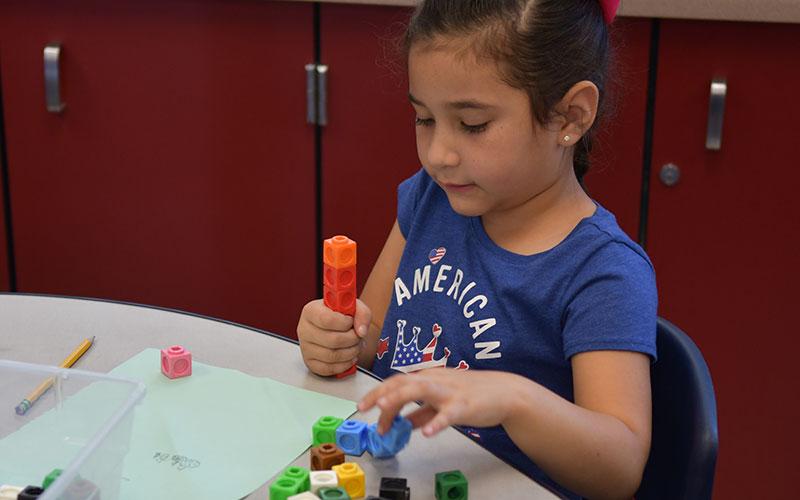



Dual-Language Programs
Immersion
Global Language Academies of Downey (GLAD) is committed to the development of bilingualism, biliteracy, academic achievement, and sociocultural competence for our students. Our G.L.A.D. program begins by exposing TK students to a second language, facilitating the transition to our dual-language immersion program starting in Kindergarten.
The immersion program follows a 90/10 model. The target language (Spanish) will be used 90% of the day for the youngest students, starting in kindergarten. Each year, more instruction will be provided in English, until a 50/50 balance is reached by the time students reach 5th grade.
By the end of the program, students will be literate in two languages.

G.L.A.D. Programs
Differences Between Our Dual Immersion Programs
There are two different Spanish Dual Immersion programs that Downey Unified families can choose from. While the main goal for both is the same (for students to become biliterate), the Dual Language Immersion and the IB Primary Years Programme do differ.
Dual Language IB PYP Program
Location:
Carpenter Elementary
Program Model:
90/10 Dual Language Model
Curriculum:
Transdisciplinary Learning. Rather than focusing on one subject at a time, students learn by making connections between two or more disciplines. Asking questions and exploring curiosity is encouraged.
Educational Goals:
Develop student agency, international mindedness, and biliteracy.
Inquiry Based Transdisciplinary Teaching
CGI Math
Balanced Literacy
- Read Aloud
- Shared Reading
- Guided Reading
- Phonics
Dual Language Program
Locations:
Imperial Elementary
Williams Elementary
Program Model:
90/10 Dual Language Model
Curriculum:
Rigorous Instructional units focused on Common Core Standards
Educational Goals:
Develop sociocultural competence, high academic achievement, biliteracy.
Instructional Approaches:
CGI Math
Balanced Literacy
- Read Aloud
- Shared Reading
- Guided Reading
- Phonics

The Benefits of Learning Spanish

Career & Travel Opportunities
- Spanish is one of the most popular languages spoken worldwide
- You will be able to communicate with over 572 million people in the world
- Spanish is the world’s second most spoken language
Boosting Vocabulary
- Learning Spanish will familiarize you with English words that have Latin roots and help you decipher new vocabulary
- Similarities to other languages. Understanding Spanish makes it much easier to pick up on other Romance languages, like Portuguese, Italian, French and Romanian, since they all evolved from Latin and share grammar, syntax, and lots of similar vocabulary
The Five Stages of Second Language Acquisition
As your child embarks on this new journey, keep in mind that this is a marathon, not a sprint. While it may be very exciting to hear your child show off their new skills, it will be some time before they have full conversations. There is a process that occurs with any second language acquisition and it generally follows the following stages:
Silent/Receptive
During this first stage, our young language learners will spend their time learning vocabulary and practicing the pronunciation of new words. They won’t normally speak the language with any fluency or real understanding. In fact, some students may choose not to speak at all. Don’t worry! This is normal. Your child may not want to share their new skills until they feel more comfortable. Our teachers are trained to identify signals of comprehension to make sure your child is understanding.
Early Production
During this stage, many language learners will acquire an understanding of up to 1,000 words and they may start putting words together to form short phrases. Students will be learning by hearing and speaking. While their vocabulary will be expanding, their sentences may be short and not be grammatically correct. That’s OK. Grammar rules come later.
Speech Emergence
During this stage, students will have acquired up to 3,000 words and will be learning to communicate by putting the words in short sentences and even questions. You may notice there are still many errors, in speaking, but during this important stage, learners gain a greater understanding of the language and will begin reading and writing in the second language. Comprehension, speaking and translating are all separate skills gained at different times. As the students begin to read more, they will gain stronger language comprehension skills and a better understanding of grammar.
Intermediate Fluency
At this stage, a student’s vocabulary will become much more robust, with as many as 6,000 words. They will be able to speak in more complex sentences. They will most importantly, start to think in their second language which will help them gain more proficiency in both speaking and writing it.
Continued Language Development/Advanced Fluency
It is essential for second language learners to continue opportunities to continue to engage in the new language. Students will need to continue expressing themselves in the second language consistently to maintain fluency in it.







